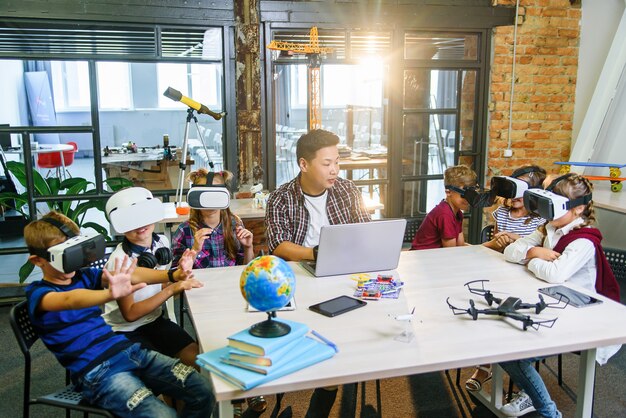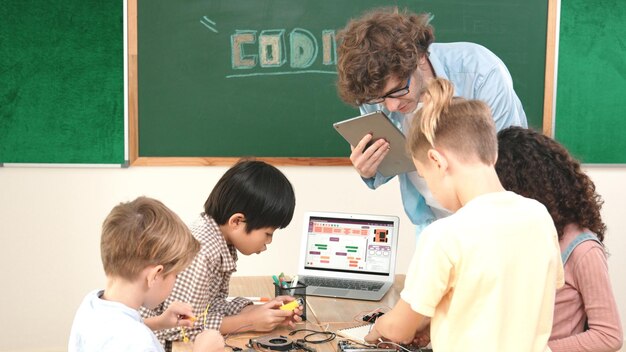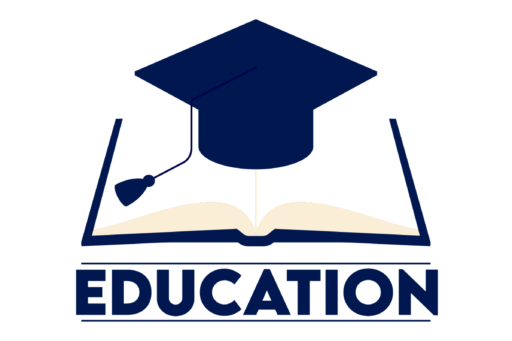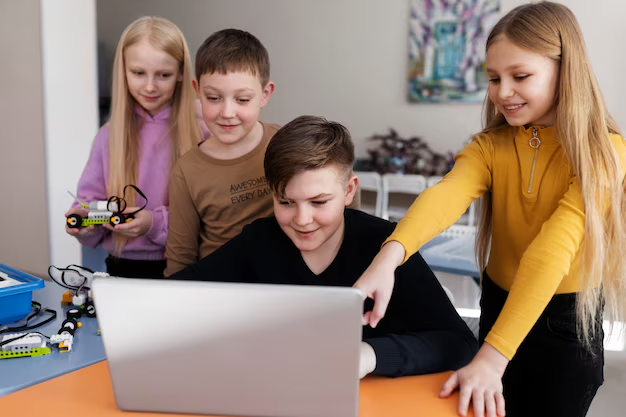The rise of educational technology (EdTech) is revolutionizing how students learn and teachers instruct. From interactive whiteboards to virtual reality, digital tools have transformed traditional classrooms into dynamic learning environments. How EdTech Is Transforming Classrooms EdTech not only makes lessons more engaging but also allows for personalized learning, immediate feedback, and access to a wealth of resources that were once out of reach.
In this blog, we’ll explore the many ways EdTech is reshaping classrooms, the benefits it brings, and the considerations that come with integrating technology into education. By understanding its transformative potential, educators, students, and parents can make the most of EdTech to enhance learning.
Personalized Learning Paths
One of the most significant advantages of EdTech is its ability to facilitate personalized learning. Unlike traditional one-size-fits-all approaches, technology allows for customized learning experiences based on each student’s pace, strengths, and areas for improvement.
A. Benefits of Personalization
Through adaptive learning software, students receive content that adjusts to their level of understanding and progress. For example:
- Math and Language Apps: These apps can assess a student’s proficiency level and tailor exercises to match, gradually increasing difficulty as the student improves.
- Learning Management Systems (LMS): Platforms like Google Classroom or Schoology provide teachers with real-time insights into student performance, enabling them to provide personalized feedback and support.
With EdTech, students receive a more tailored learning experience, fostering better engagement and academic outcomes.
Gamified Learning for Increased Engagement
Gamification uses game-like elements to make learning more engaging. By incorporating rewards, point systems, and challenges, EdTech taps into students’ natural love for games to enhance motivation and make learning fun.
A. Benefits of Gamification
Gamified learning encourages students to set goals, work through challenges, and experience a sense of accomplishment. This approach is particularly effective for young learners who may have shorter attention spans. It has also been shown to improve knowledge retention, as students are more likely to remember lessons learned through engaging activities.
B. Examples of Gamified Learning
There are several ways gamification is being used in classrooms:
- Quizzes and Challenges: Platforms like Kahoot! and Quizizz turn quizzes into competitive, fun experiences where students can compete for points.
- Interactive Learning Games: Subjects like history, math, and science are brought to life through interactive games, such as virtual treasure hunts or educational quests, where students earn badges and rewards for completing levels.
By blending education with play, EdTech makes classrooms more engaging and helps students feel more invested in their learning journey.

Enhanced Collaboration and Communication
Technology facilitates collaboration by providing platforms for students to work together, share ideas, and solve problems, regardless of their physical location.
A. Benefits of Collaborative EdTech Tools
Collaborative tools break down barriers, allowing students to learn from each other’s perspectives and strengths. These tools also help foster essential skills like teamwork, problem-solving, and effective communication.
B. Examples of Collaborative EdTech in Action
Various tools encourage collaboration among students:
- Digital Whiteboards: Tools like Google Jamboard and Miro allow students to brainstorm, sketch, and share ideas in real time, whether they’re in the classroom or learning remotely.
- Project-Based Platforms: Platforms like Microsoft Teams and Slack give students spaces to collaborate on group projects, share documents, and communicate, replicating the experience of working in a team environment.
These tools make collaboration more accessible and efficient, enhancing student engagement and preparing them for a tech-savvy future.
Expanding Access with Online Learning
EdTech has made learning more accessible by breaking down geographical and financial barriers. Online courses and virtual classrooms provide students from various backgrounds access to quality education.
A. Benefits of Increased Accessibility
Access to online learning platforms has transformed education for students in remote or underserved areas. By connecting students with high-quality teachers and resources from around the world, EdTech democratizes education and ensures that everyone has an opportunity to learn.
B. Examples of Online Learning Platforms
EdTech has popularized platforms that make learning resources available to everyone, such as:
- Massive Open Online Courses (MOOCs): Platforms like Coursera and edX offer a wide variety of courses, enabling students to access content from prestigious universities at low or no cost.
- Remote Learning Platforms: Apps like Zoom, Google Meet, and Microsoft Teams facilitate virtual classrooms, allowing students to attend lessons from home or any other location.
Through online learning, EdTech offers flexibility and broadens access, allowing students from diverse backgrounds to pursue education at their own pace.
Immediate Feedback for Continuous Improvement
One of EdTech’s transformative impacts on education is the ability to provide immediate feedback, allowing students to learn from mistakes and make adjustments in real time.
A. Benefits of Instant Feedback
Immediate feedback is crucial for student learning, as it allows students to recognize and correct errors quickly. It helps students build confidence and stay motivated by tracking their progress more closely.
B. Tools for Immediate Feedback
Various EdTech tools make it possible for students to receive instant feedback:
- Automated Quizzes and Assignments: Apps like Google Forms and Canvas offer auto-grading options for quizzes and assignments, giving students instant results and feedback.
- AI-Powered Learning Apps: Platforms like DreamBox and Khan Academy use AI to assess student performance and offer instant suggestions for improvement.
With instant feedback, students can make quick adjustments to their learning strategies, resulting in a more effective learning process.
Immersive Learning Through Virtual and Augmented Reality
Virtual Reality (VR) and Augmented Reality (AR) technologies create immersive learning experiences that were once unimaginable. From virtual field trips to interactive science labs, VR and AR make complex concepts easier to grasp.
A. Benefits of Immersive Learning
Immersive learning experiences enhance student engagement and retention by providing hands-on interaction with educational content. Complex subjects like anatomy, physics, and history come to life in ways that traditional methods can’t replicate.
B. Examples of VR and AR in the Classroom
There are various ways VR and AR are being used to create immersive learning environments:
- Virtual Field Trips: Apps like Google Expeditions allow students to “travel” to places like the Great Wall of China or the International Space Station without leaving the classroom.
- Interactive Science Labs: Tools like Labster provide virtual labs where students can conduct experiments in a simulated environment, offering a safe and cost-effective way to learn.
VR and AR enhance understanding by allowing students to engage directly with content, making abstract concepts more concrete.

Data-Driven Teaching
Data collection and analysis are helping teachers gain insights into student performance, strengths, and areas for improvement, enabling them to tailor instruction more effectively.
A. Benefits of Data-Driven Insights
Data-driven teaching allows educators to make more informed decisions, targeting areas where students need the most support. It also empowers teachers to identify trends, adapt to students’ needs, and improve overall classroom effectiveness.
B. Tools for Data-Driven Instruction
EdTech provides several platforms for collecting and analyzing student data:
- Learning Management Systems (LMS): Systems like Canvas and Blackboard track student performance, allowing teachers to monitor progress and adjust lessons accordingly.
- Assessment Tools: Programs like GoGuardian and Illuminate Education offer data analysis features that help teachers understand individual and group learning needs.
By using data, teachers can create more targeted, effective lessons and ensure that every student receives the support they need.
Conclusion
EdTech is transforming classrooms by personalizing learning, increasing engagement, expanding access, and providing tools for collaboration, feedback, and immersive experiences. By embracing technology, educators can create classrooms that are more inclusive, flexible, and effective in meeting the needs of modern learners.
However, the integration of EdTech also requires thoughtful planning to ensure that it enhances, rather than disrupts, the learning experience. Teachers, administrators, and parents all play a vital role in supporting responsible and productive use of technology in education.
With its transformative potential, EdTech continues to open new horizons in education, promising a future where learning is more accessible, engaging, and adaptable than ever before.

